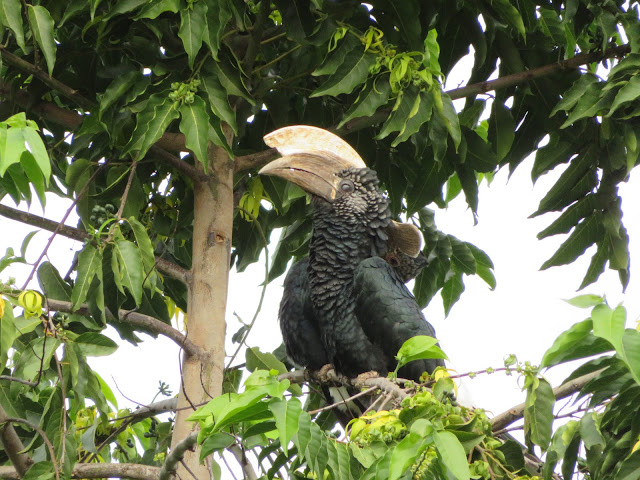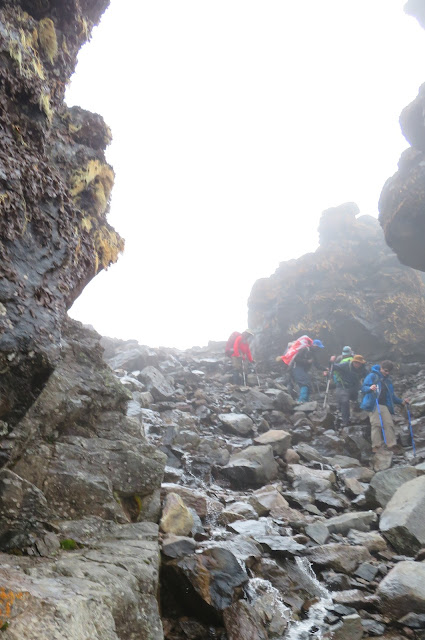 |
| Caspar took this photo of the sunrise...I was too busy trying to breathe. |
I'm not sure if anyone else remembers the animated Pippi Longstocking movie from the 90s (maybe it's just me because I finally found someone with hair that looked like mine), but the opening song from the film factors into summit day. The song is called "What Shall I Do Today" and the opening lines are "Standing on top of Mount Kilimanjaro/Watching the Sunrise, the wind in my hair/I'm gonna go wherever I wanna go/there's magic everywhere..." I literally sang that opening verse dozens of times on Summit Day.
Summitting Mount Kilimanjaro is without doubt, the hardest thing I have done mentally and physically in my entire life. It took everything I had to make it up that mountain. Maybe in different weather conditions it would be a different story, but in the midst of sleet and snow, it was ridiculously tough.
I woke up from a light doze to the sound of rain pelting the tent. I said to myself, "I hope it isn't almost 11, because I don't want to hike in this crap." I looked at my watch...10:55 pm. Shoot! A few minutes later, there was a knocking on our tent saying it was time to wake up. I put on my first longsleeve base layer, followed by my fleece base layer, followed by inner jacket, and lastly my outer jacket on top. On the bottom it was light base layer pants, fleece base layer pants, hiking pants, with rain pants on the outside. I had a balaclava tucked into my layers on top and pulled over my head, with my warm ISU beanie on top. I had my warm ski gloves on my hands...once we got going.
We had a light breakfast. I certainly wasn't hungry and neither were most people. We were complaining about the rain and Caspar said it would turn to snow before we left for the summit. We were told it almost never rains up at Barafu Camp, but there we were, at nearly midnight and it was raining. They told us what order we'd be hiking in. I was given number 6 and Alex would be bringing up the rear at 9. Just as we were getting ready to set out the rain turned to a wet snow. Guess Caspar was right.
 |
| One of our superporters took this photo of us trekking along behind Caspar. |
Besides our four guides Caspar, Simon, Joseph, and Emmanuel, we also had 6 additional porters with us to help us out. Essentially one per person. The goal was to stay together, but if necessary, one would stay with us to help us out. We would not have made it up the mountain without them.
As we set out, headlamps on, we passed other camps and could see lights in some tents as their people were getting ready to set out as well. We slowly pushed up the mountain. It is hard to say what was out there because it was snowing and dark so we couldn't see far. After a little bit we reach a rocky area that we were to climb. The snow was slick on the rocks and our superporters helped us out by giving us a hand. In less snowy times, I think the path would have been a grueling series of switchbacks and some small scrambles, but the snow made it almost as if for every two steps forward you took, you went one back, because your feet were slipping under you.

To start with we took a few minute break every 20-30 minutes. The higher on the mountain we got, the further apart the breaks got. There were so many people on the mountain making their way up. If you looked up you could see the glow of headlamps up above. I figured the furthest group up that I could see was probably at least 50 vertical meters up from us. If you looked down you could see the lights of people who started after us. Occasionally we would stop and let someone pass us, or we would pass another group. We were one of the larger groups that I saw. When we were talking afterwards, some of the group said they had to stop looking up because it was disheartening to see the lights still going up. For me it was a goal..."I can make it up to where they are."
Four hours in I had to give up my daypack. Caspar looked at me during a break and asked how I was feeling. I said my legs were tired and he told one of the superporters to take my daypack. This took about 10 lbs off my back which instantly helped, but it did mean my access to my water was somewhat restricted the rest of the way. I could only get to it when we stopped for a break. At one point when we were on a break, one of the guides opened up what was literally a bag of sugar and told us to open our mouths. He poured sugar in and for about 5 minutes it totally helped. And then it had run its course.
Partway up the mountain, Jay, aka Baba Simba, started using the portable oxygen that he had paid for to help him out on the climb to the summit. The rest of us just pushed on with what we could get from the air. At the top of Kilimanjaro there is approximately 52% less oxygen than at sea level. It was probably in the 17,000 foot range that I started to really notice the altitude kicking in. A headache began and by the time we reached the top I was nauseous, but not quite feeling like I was going to throw up, but just like I could.
The sky eventually started to lighten. We were probably about 100-200 vertical meters below Stella Point (the point at the crater rim that we were aiming for before heading to the peak) when sunrise hit. We stopped and watched, and it had to be one of the most beautiful sunrises I've ever seen. Kansas can have some pretty ones, but this was something else entirely. After the sun was up, we made our final push for the top.
 |
Making our way from Stella Point to Uhuru Peak.
Caspar, Ashely, Me, Tim, Bre, Mimi, Ben |
Making it up to Stella Point was huge. I felt that if I made it up there, I could definitely make it to the top. We stopped for a brief tea and snack break before heading off for Uhuru Peak, the summit. The snow up top was probably a meter deep; more in some places, less in others. It took probably somewhere around 45 minutes to make the trek from Stella Point to Uhuru Peak. You could see down into the volcanic crater one way, and to some glaciers the other way.

Finally, the sign for Uhuru Peak was ahead. We made it! 19,341 feet! We took a bunch of photos. Individual photos and some group photos. Of our group, Sunny was a bit further behind so missed the group photo and Alex had to turn back hours earlier due to issues with the altitude. We stayed up at Uhuru Peak for maybe 10-15 minutes. Really just long enough for everyone to take photos and get one last look around and then we turned back to Stella Point. We took one last, quick break at Stella Point (I peed at the top of Mount Kilimanjaro! 18,885 ft!), and then down we went.

Down was the part I was dreading. I can go up any day. I might get slower and slower, but I will keep going. Down is scary and hard on my knees. And the way they want you to go down, as quickly as possible is even scarier. I get why they wanted us to get down. We had already been hiking for probably 10 hours and the quicker you can get to a lower elevation, the better off you'll feel. They showed us the key to get down a snowy mountain quickly and it involved almost slip skiing down the mountain. Hit a patch of snow at an angle and you can get down probably 8-10 feet in a slip. But you have to be careful. At one point and we were getting lower, I slipped and hit the back of my head on the ground, which totally didn't feel good. I didn't go unconscious at all, but the headache I was dealing with suddenly doubled in pain. Thankfully we stopped about 10 minutes later and Bre had some good pain reliever on hand to give me.

Some of our porters who had stayed behind had come out to meet us with juice and that was extremely welcome. They helped guide our exhausted selves back to camp, which was still probably an hour more at least. And to make matter more fun, after dealing with warm sun that had us stripping layers off on the side of the mountain, the rain reappeared.
Exhausted and tired beyond reason, we stumbled into camp where we were to change quickly and then eat lunch. Due to the nausea I had been feeling since near the top, I totally wasn't into food. I ate a little because I knew I needed too, but I couldn't stomach much. After lunch we set off again...because climbing and descending 4500 vertical feet isn't enough, we also had to continue down to the Millennium Camp, which was an additional 2000 feet down. At least this part wasn't as steep as coming down from Lava Tower was, or coming down from the summit. It was just a continuous downward slope.
The thing that kept me going, was I knew down at camp was my tent and sleeping bag, and dry shoes. I was beyond exhausted and camp just wouldn't get any closer. Because it was below us, we could see it a lot sooner and it didn't look that far away...but it totally was. The guides were good at fooling you. "Yeah, we're almost there." "If we take just a short break, we could be there in 30 minutes." ...One Hour Later...
When we stumbled into camp, Alex was there waiting for us. He told us he had reached a point probably around 16,500 where his body just lost all energy and he couldn't go. Simon told him he could keep trying, but it would probably be best if he turned around and went back to camp. So Alex and Simon went back down to the Barafu Camp where he napped for a couple hours. They then packed up our tent and the two of them, along with a few porters, made their way to Millennium Camp. Alex said he napped some more there as well.
That evening, for supper, Peter the cook made a cake! It was delicious, and about the only thing I wanted to eat. I tried the rice and the potatoes, but couldn't eat any of it. But I got a good slice of cake down.
When I went to bed that night, I slept like a rock. Alex said that it was obvious that I was dead asleep the few times he got up to go to the bathroom. Day 7 was the longest and most thrilling day of my life! And I have a certificate and photos to prove it!

















































